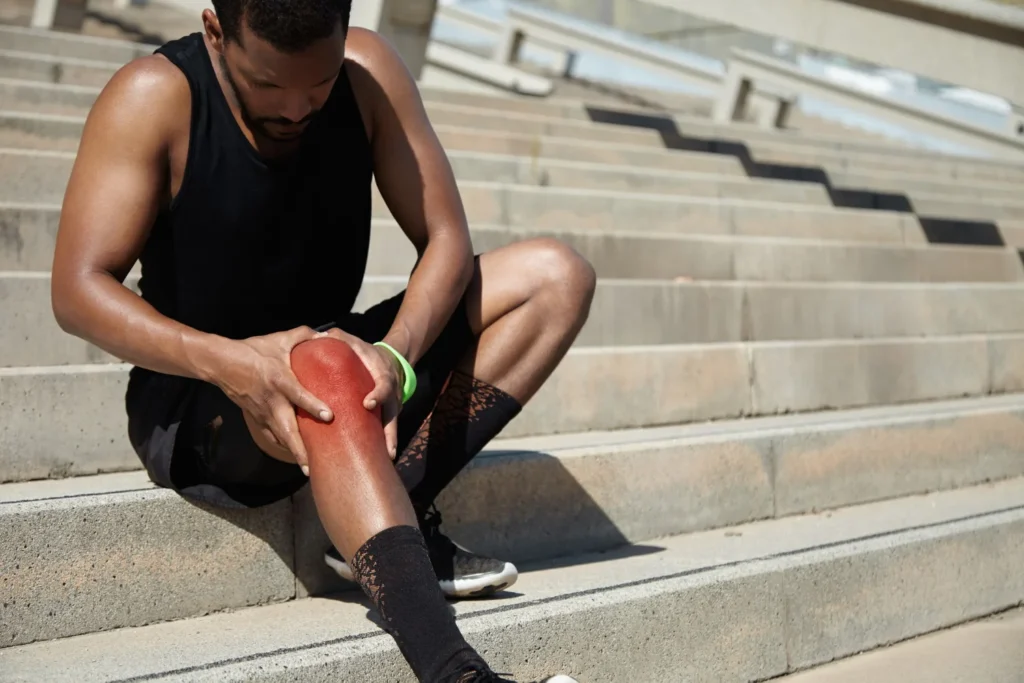I’ve seen it time and time again athletes sidelined by injuries that could’ve been avoided. Whether it’s a sprained ankle, a pulled hamstring, or a torn ligament, common sports injuries can seriously disrupt progress, performance, and confidence. It’s frustrating, and as someone who’s experienced this firsthand, I know how much it hurts both physically and mentally.
But here’s the good news: with the right preventative measures, many of these injuries can be avoided altogether. From proper warm-ups and strength training to smart recovery habits, there are proven ways to protect your body and keep performing at your best without setbacks.
In this guide, I’ll walk you through simple, science-backed strategies that help keep athletes safe. Whether you’re a beginner or a pro, what you’ll read below can make a real difference in your game and your health.
Why Injury Prevention Is Essential in Sports

Injury prevention isn’t just about avoiding pain. It’s about longevity in sport. A single injury can set an athlete back for weeks, months, or even end a promising career. The physical toll is obvious, but the mental cost is equally damaging. Fear of reinjury, lack of confidence, and disrupted training routines can all derail long-term goals.
The most common sports injuries such as ACL tears, muscle strains, or tendonitis are often linked to repetitive movement, fatigue, or poor training habits. Thankfully, many of these issues are avoidable. Sports science and physical therapy have given us the tools to train smarter, not just harder.
Prevention isn’t complicated. In fact, small adjustments in training, posture, and routine recovery practices can create massive improvements in injury resistance. Taking the time now to apply preventative strategies is far more effective than dealing with rehabilitation later.
Most Common Sports Injuries Athletes Face
Here are the injuries athletes encounter most often across various sports:
| Injury Type | Common Sports | Body Area Affected | Risk Level |
|---|---|---|---|
| Ankle Sprain | Basketball, Soccer | Ankle Ligaments | High |
| Hamstring Strain | Sprinting, Football | Back of Thigh | High |
| ACL Tear | Soccer, Skiing, Football | Knee Ligament | High |
| Shin Splints | Running, Track Events | Lower Leg | Medium |
| Rotator Cuff Tear | Baseball, Swimming | Shoulder | Medium |
| Tennis Elbow | Tennis, Golf | Elbow Tendons | Medium |
Recognizing these injuries helps you prepare better, train smarter, and identify early signs before they become serious.
Understanding the Root Causes of Sports Injuries
1. Poor Warm-Ups and Cool-Downs
Skipping dynamic warm-ups reduces blood flow and muscle elasticity, making you more prone to strains and sprains.
2. Muscle Imbalances and Overtraining
Focusing too much on one muscle group creates imbalance, leading to improper joint movement and higher injury risk.
3. Inadequate Technique or Equipment
Using the wrong form or gear causes unnecessary strain on joints and muscles.
4. Lack of Rest and Recovery
Overuse without enough recovery time breaks the body down faster than it can heal, increasing the chance of chronic injuries.
Science-Backed Preventative Measures That Actually Work
Here are the most effective, proven methods to prevent common sports injuries:
- Dynamic Warm-Ups – Replace static stretches with light cardio and joint mobility drills.
- Sport-Specific Strength Training – Tailor workouts to mimic your sport’s movement patterns.
- Functional Movement Assessments – Identify weaknesses and correct them early.
- Use of Protective Gear – Braces, wraps, or shoes designed for your sport can make a huge difference.
- Proper Nutrition and Hydration – Muscles need fuel and hydration to function properly.
- Scheduled Recovery Days – Include full rest days in your weekly routine.
- Cross-Training – Mix up activities to avoid overuse of the same muscles.
Daily Habits That Reduce Injury Risk Long-Term
Daily habits play a major role in injury prevention. Here are some key routines you can easily add:
- Foam Rolling: Enhances blood flow and reduces muscle tightness.
- Mobility Work: Keeps joints functional and increases movement quality.
- Balanced Workouts: Target both major and minor muscle groups.
- Posture Check-ins: Especially important if you sit for long hours.
- Sleep Schedule: 7–9 hours of quality sleep helps repair tissues.
- Hydration: Drink water throughout the day not just during workouts.
Build consistency with these small habits and you’ll see big results over time.
Role of Physiotherapists in Injury Prevention

Physiotherapists are key allies in helping athletes stay injury-free. They can:
- Perform biomechanical assessments to spot weaknesses.
- Design personalized prehab routines.
- Provide manual therapy (like dry needling or myofascial release).
- Guide recovery plans based on sport, age, and condition.
I personally recommend visiting a physiotherapist at least once per season to stay on top of your movement patterns and ensure your training is balanced.
Sport-Specific Injury Prevention Tips
For Runners:
- Strengthen glutes and core muscles.
- Replace shoes every 300–500 miles.
- Avoid increasing mileage by more than 10% weekly.
For Soccer Players:
- Prioritize ankle stability and hip mobility.
- Practice safe landing mechanics after jumps.
For Swimmers:
- Do shoulder mobility exercises.
- Mix strokes to avoid repetitive strain.
For Golfers & Tennis Players:
- Stretch wrists, shoulders, and back regularly.
- Strengthen forearm and rotator cuff muscles.
For Lifters & CrossFit Athletes:
- Always warm up joints before lifting heavy.
- Focus on form over weight progression.
Injury Prevention Equipment and Tools You Should Consider
| Equipment | Purpose | Suitable For |
|---|---|---|
| Resistance Bands | Strengthen stabilizer muscles | All athletes |
| Foam Roller | Reduce muscle tension and soreness | Runners, Lifters |
| Ankle Braces | Prevent re-injury after a sprain | Soccer, Basketball players |
| Compression Sleeves | Improve circulation and support | Runners, Tennis players |
| Balance Board | Improve ankle and knee stability | Skiers, Trail Runners |
Using the right tools in training can drastically reduce your chances of injury.
Tracking Your Progress and Staying Consistent
Monitoring your performance is one of the most underrated forms of injury prevention. Here’s a basic tracker:
| Metric | Ideal Frequency | Notes |
|---|---|---|
| Sleep Hours | 7–9 hours/night | Affects recovery and focus |
| Hydration Intake | 2–3 liters/day | Varies with climate/training |
| Mobility Score | Test monthly | Measure ankle, hip, shoulder |
| Soreness Level | Rate 1–10 after workout | Avoid training if 7+ |
| Pain Points | Daily check | Track persistent discomfort |
Keeping a log will help identify patterns before they become problems.
Common Myths About Sports Injury Prevention
- Myth: Stretching prevents all injuries.
Truth: Dynamic warm-ups and strength matter more than passive stretching alone. - Myth: You should push through the pain.
Truth: Pain is a signal, not a weakness. Rest when needed. - Myth: Only professionals need injury prevention.
Truth: Every level of athlete benefits from prevention routines. - Myth: Equipment alone will protect you.
Truth: Gear supports your body, but technique and training prevent injuries.
Final Thoughts: Prioritize Prevention, Perform Better
Injury prevention isn’t about playing it safe. It’s about playing smart. I’ve learned that when I take care of the small things consistently, the big results follow. Staying injury-free means you can train harder, perform better, and enjoy your sport longer.
Whether you’re just starting out or chasing high-level competition, implementing preventative measures is the most effective investment you can make in your athletic future. It saves time, reduces pain, and keeps you on track toward your goals.
Commit to the process, listen to your body, and don’t wait for an injury to teach you what prevention could have saved. Let this guide be your first step toward smarter, safer performance.
Also Read:
- Why Pain Medication is Not Always the Best Option for Pain Relief
- 6 Common Foot and Ankle Problems: Causes and Treatments
Frequently Asked Questions (FAQs)
What’s the best way to prevent sports injuries?
Start with dynamic warm-ups, proper form, balanced training, and enough recovery. Consistency in these areas reduces risk.
How often should I see a physiotherapist?
At least once every season or after any pain flare-up. Regular checks can catch issues before they become serious injuries.
Do I need to wear braces or supports?
Only if you’re recovering from injury or playing high-risk sports. They should supplement, not replace, good training habits.
Can hydration really affect injury risk?
Yes, dehydration increases fatigue and muscle cramps, which raise the chance of strains or tears during activity.
What if I feel pain but no injury is visible?
Always listen to your body. Pain is an early warning sign rest, ice, and see a professional if it persists.





